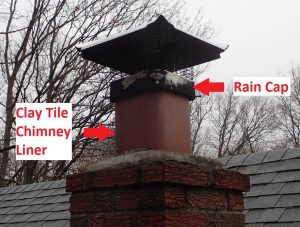Almost every home that I inspect has at least one chimney. While they are usually constructed from traditional masonry (bricks and mortar) chimneys can also be made from concrete block, metal or other materials. Sometimes a chimney is associated with a fireplace, but more often I find chimneys associated with heating systems and water heaters.
Most chimneys can handle quite a bit of neglect before they succumb to problems such as water infiltration, improper venting or even chimney fires. With every home inspection I recommend that my clients contact a certified chimney sweep to thoroughly examine and clean the interior of all chimneys and make any needed repairs. This commonly involves a Level II inspection in which a chimney sweep lowers a camera into the flues to look for cracks, deterioration to the flue liner, missing mortar and other problems.
 Chimneys have a few areas where they are especially vulnerable. On interior chimneys, or chimneys that come up through a hole in the roof, the flashing at the base of the chimney where it intersects the roof is a common place for water to find its way into the home. Lead is generally used as the visible counter flashing, and when a homeowner calls a roofer to stop a leak around a chimney the lead flashing is typically covered with black roof cement. This is a pretty easy and effective way to stop a leak, but it should always be considered a temporary repair. After several years the roof cement will get dried out by the sun, will develop cracks and very likely the leak will reappear. More tar is commonly applied at that point, but the correct repair is to remove tar-covered flashing and replace it. You should always make sure that your roofing contractor includes flashing replacement when it comes time for a new roof.
Chimneys have a few areas where they are especially vulnerable. On interior chimneys, or chimneys that come up through a hole in the roof, the flashing at the base of the chimney where it intersects the roof is a common place for water to find its way into the home. Lead is generally used as the visible counter flashing, and when a homeowner calls a roofer to stop a leak around a chimney the lead flashing is typically covered with black roof cement. This is a pretty easy and effective way to stop a leak, but it should always be considered a temporary repair. After several years the roof cement will get dried out by the sun, will develop cracks and very likely the leak will reappear. More tar is commonly applied at that point, but the correct repair is to remove tar-covered flashing and replace it. You should always make sure that your roofing contractor includes flashing replacement when it comes time for a new roof.
The interior of the chimney should always be lined. If your home was built at the turn of the century or earlier, you may have an unlined chimney. The most common liners used during construction are clay tiles. The most common material used after-the-fact or for chimney re-lining is flexible stainless steel. After decades of use a clay tile liner can start to deteriorate. This is especially true for chimneys that are venting combustion products from natural gas. Pieces of the clay tile liners can chip off and fall to the bottom of the chimney where they can pile up and obstruct the pathway of gases being vented out of the home. Look for a steel cleanout door at the base of the chimney, often in the basement or garage. You might be surprised at how much debris is in there needing to be removed.
 If the inside of your chimney is too far gone, you may find that you don’t have too many options other than re-lining the chimney. If it’s still in pretty good shape you should try to keep it that way by installing a rain cap. This is a small metal structure that is attached to the very top of the chimney. Not only does it keep out the rain, but the majority of rain caps also have screening that helps keep the critters out. More than one phone call has been made to remove a squirrel or even a raccoon out of a chimney.
If the inside of your chimney is too far gone, you may find that you don’t have too many options other than re-lining the chimney. If it’s still in pretty good shape you should try to keep it that way by installing a rain cap. This is a small metal structure that is attached to the very top of the chimney. Not only does it keep out the rain, but the majority of rain caps also have screening that helps keep the critters out. More than one phone call has been made to remove a squirrel or even a raccoon out of a chimney.
Your chimney may be long overdue for some attention. As your home inspector I recommend that you look to the Chimney Safety Institute of America for a Certified Chimney Sweep.
